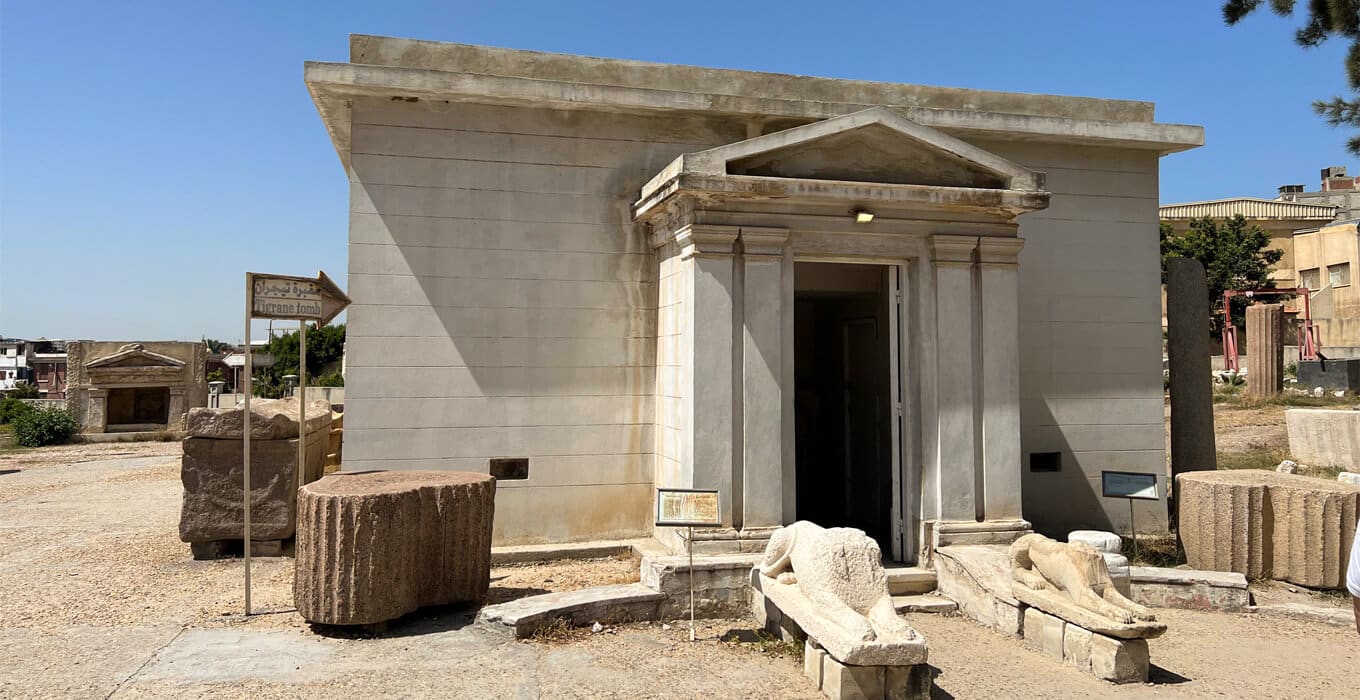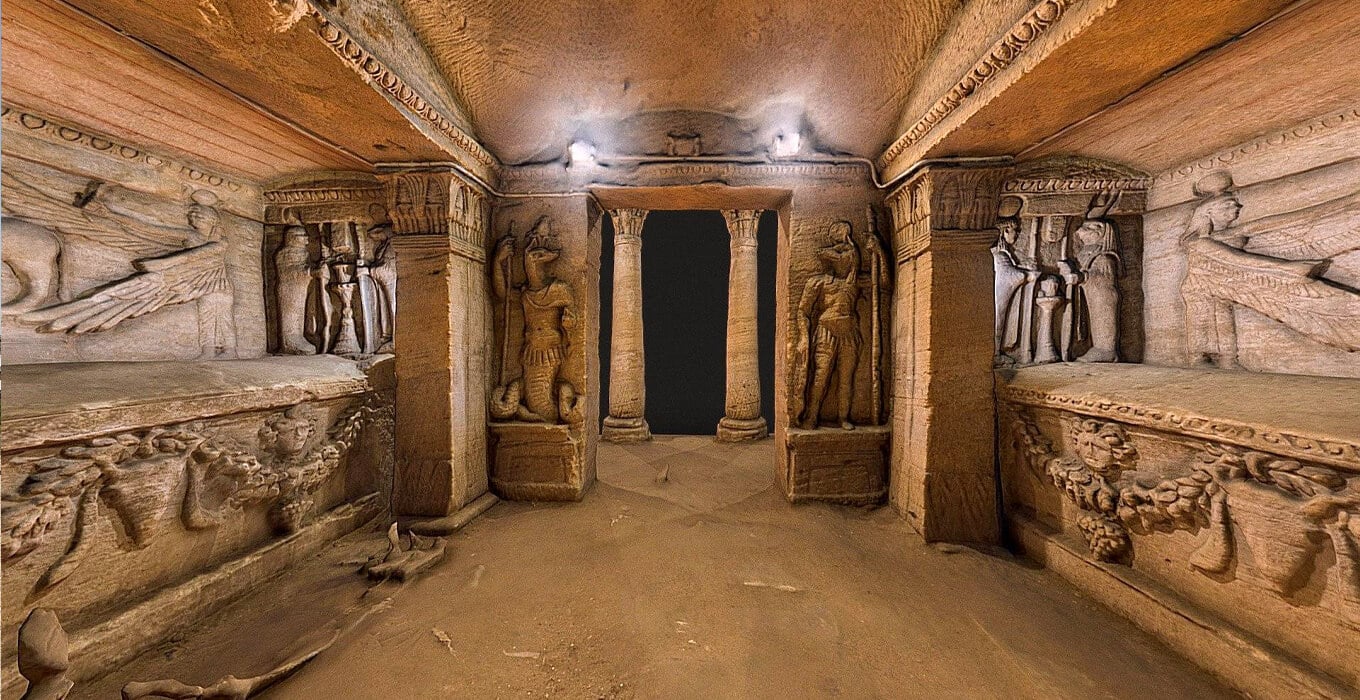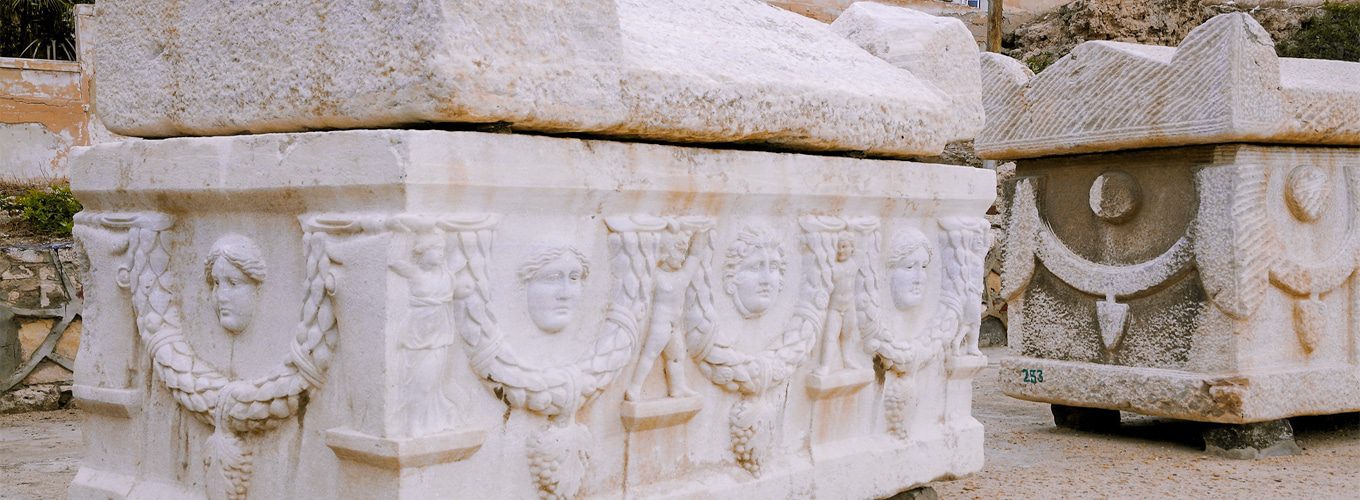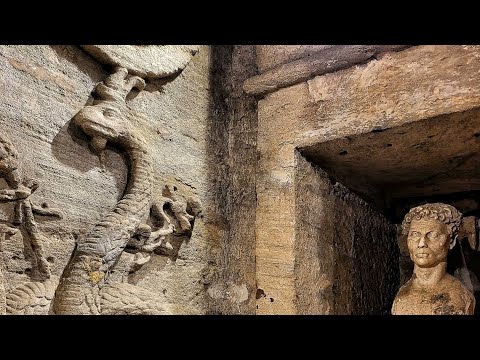100 feet below Alexandria, Egypt lies a hidden wonder. The Catacombs of Kom El Shoqafa date back to the 2nd century AD. They show how Egyptian, Greek, and Roman cultures mixed in ancient Alexandria.
This underground site was once one of the Seven Wonders of the Middle Ages. It’s a key spot for those who love ancient history and architecture.
Key Takeaways
- The Catacombs of Kom El Shoqafa are an ancient necropolis and one of the Seven Wonders of the Middle Ages, located in Alexandria, Egypt.
- This underground burial site dates back to the 2nd century AD and exhibits a unique blend of Egyptian, Greek, and Roman architectural and cultural influences.
- The catacombs extend across three levels, carved into the bedrock, and served as a burial site and gathering place for the local population until the 4th century AD.
- Rediscovered in 1900, the catacombs feature intricate carvings, sarcophagi, and relics that provide a glimpse into the ancient Alexandrian society.
- The catacombs were named Kom El Shoqafa, meaning “Mound of Shards,” due to the presence of broken terra cotta objects left by visitors over the centuries.
Introduction to the Catacombs of Kom El Shoqafa in Alexandria
The Catacombs of Kom El Shoqafa in Alexandria are a key archaeological site. They show how ancient Egyptian, Greek, and Roman cultures mixed during the Ptolemaic dynasty. Built in the 2nd century AD, this underground place was for burials and meetings.
It highlights the mix of different artistic and architectural styles.

Overview of the Catacombs’ Historical Significance
The Catacombs of Kom El Shoqafa are famous for their size, detailed design, and mixed art styles. They were used until the late 4th century A.D. It was a major place for burials in the Ptolemaic and Roman times.
Unique Blend of Architectural and Cultural Influences
The Catacombs show a special mix of architectural and cultural styles. They combine Egyptian, Greek, and Roman designs. The place has statues, reliefs, and inscriptions that blend different traditions.
This mix shows the Ptolemaic dynasty’s aim to bring Greeks and Egyptians together. It also shows Alexandria’s history as a place where cultures merged.
The Discovery and Excavation of the Kom El Shoqafa Catacombs
The Catacombs of Kom El Shoqafa were hidden for a long time. They were found by accident in 1900. A donkey fell into an ancient tomb’s shaft in Alexandria, showing the world these hidden places.
Accidental Unearthing by a Donkey in 1900
After the donkey fell, German archaeologists started to dig and study the Catacombs. They found a spiral staircase, a domed room, and many artifacts. These finds showed how big and complex the underground city was.
Initial Explorations by German Archaeologists
The Catacombs date back to the 2nd century AD. They could hold up to 300 bodies and mixed Roman, Egyptian, and Greek styles. The German archaeologists’ work showed us this secret place that was hidden for so long.
|
Key Statistics |
Details |
|
Depth of the Catacombs |
30 meters across three levels |
|
Burial Capacity |
Up to 300 corpses |
|
Architectural Influences |
Roman, Egyptian, and Greek |
|
Excavation Beginnings |
1892, with the discovery made on September 28th, 1900 |
The Catacombs’ Architectural Marvels
Under Alexandria’s busy streets, the Catacombs of Kom El Shoqafa hide a world below. This place mixes Egyptian, Greek, and Roman designs. At its center, a spiral staircase goes down, leading to a big, round room called the rotunda.
Spiral Staircase and Rotunda
The spiral staircase shows the skill of the builders. It takes you deeper into the underground. The rotunda, with its dome, opens up to many cultural and artistic treasures in the Catacombs of Kom El Shoqafa.
Roman-Style Dining Hall
Further down, a Roman-style dining hall was found. It was probably for feasts in memory of the dead. This shows the mix of cultures in the Catacombs of Kom El Shoqafa. In ancient times, feasts for the dead were common in the Mediterranean. This hall highlights the unique blend of cultures in this place.
The Hall of Caracalla (Nebengrab)
The Catacombs of Kom El Shoqafa have a spooky spot called the Hall of Caracalla, or Nebengrab. It was likely a place where many people were buried together after a big massacre in 215 AD. This was done by the Roman emperor Caracalla. Archaeologists found lots of human and horse bones there, showing the horror of the mass slaughter.
To get into the Hall of Caracalla, you have to go through a hole in the rock from the first level. Some think it was where Caracalla killed young Christians, but there’s no proof of this. The tomb shows off a mix of Egyptian and Greco-Roman influences, showing how rich in culture ancient Alexandria was.
Using infrared photography, we see the tomb’s smart design. It has a double style found in Roman tombs. The top part shows the Egyptian mummification of Osiris. The bottom part tells a Greek myth story about Persephone being taken by Hades and coming back to life. This story matches the Egyptian tale of Osiris’ rebirth.
There are also bones of horses in the tomb, which might be for Nemesis, the Greek goddess of revenge. The tomb’s designs change between Egyptian and Greek styles. This shows the cultural differences of ancient Alexandria.
The Hall of Caracalla still draws in visitors and researchers. It gives us a peek into the Catacombs of Kom El Shoqafa and the diverse cultures of ancient Alexandria.
Entering the Main Tomb
As you go down into the Catacombs of Kom El Shoqafa, you see two statues at the entrance. One is dressed in Egyptian clothes but has a Roman hairstyle. The other is a nude woman, showing ancient Greek art.
At the top, above the door, you’ll see carvings of bearded serpents. They are of the Greek spirit Agathodaemon and the scary Medusa. These carvings keep away bad people and keep the tomb safe.
Statues and Inscriptions at the Entrance
The statues and writings at the entrance show Egyptian and Greco-Roman styles. You see an Egyptian-looking figure and a nude Greek woman. This shows the mix of cultures at the Catacombs of Kom El Shoqafa back then.
Agathodaemon and Medusa Carvings
Carvings of Agathodaemon and Medusa are above the main tomb entrance. Agathodaemon, a Greek spirit of good luck and wisdom, wears the Egyptian double crown. Medusa, a scary figure from Greek stories, looks out to keep away grave robbers and protect the tomb.
The Burial Chamber and Its Reliefs
The Catacombs of Kom El Shoqafa show a mix of ancient Egyptian and Greco-Roman art. In the main burial chamber, archaeologists found three big sarcophagi with Roman-style decorations. These stone coffins have carvings of garlands, gorgon heads, and ox skulls.
These Roman-style sarcophagi show that the Catacombs were for important people in ancient Alexandria. The detailed carvings prove the mix of cultures in this necropolis.
Reliefs of Egyptian Deities and Pharaohs
The walls of the main burial chamber have reliefs that mix Egyptian and Greco-Roman styles. The central panel shows Osiris, the god of the afterlife, being mummified by Anubis. Near it, panels show the Egyptian bull god Apis getting offerings from a pharaoh, watched by a goddess like Isis or Maat.
These reliefs show how ancient Egyptian and Greco-Roman traditions blended together. The Catacombs of Kom El Shoqafa highlight the unique cultural mix of this ancient site.
Catacombs of Kom El Shoqafa in Alexandria

The Catacombs of Kom El Shoqafa are a deep wonder carved over centuries. They show the rich culture and smart design of ancient Alexandria. Found in 1900 after a donkey fell through the ground, they were a place for burials and meetings in the Ptolemaic period.
This site is the biggest Roman burial place in Egypt. It has three levels of tombs and chambers, going 35 meters deep. Over 300 years, it grew to hold over 300 bodies in special niches.
The triclinium, a Roman-style dining area, is a key feature. Here, people would eat and mourn on raised benches. It shows how Egyptian, Greek, and Roman traditions mixed in the site’s design and art.
“The Catacombs of Kom El Shoqafa in Alexandria represent a remarkable blend of cultural influences, showcasing the enduring legacy of this ancient civilization.”
Even though they’ve been damaged by water, the Catacombs still amaze visitors with their size and art. They are a key spot in Alexandria. They let us see into the lively and mixed society of ancient Alexandria during the Ptolemaic period.
The Fusion of Egyptian and Greco-Roman Cultures
The Catacombs of Kom El Shoqafa in Alexandria, Egypt, show how ancient Egyptian and Greco-Roman cultures came together. This happened during the Ptolemaic dynasty. The Ptolemaic family wanted to bring people together under one rule. They mixed art styles and beliefs, which we see in the catacombs.
Influence of the Ptolemaic Dynasty
The Ptolemaic dynasty ruled Egypt from 323 to 30 BC. They made Alexandria a place where Greek, Roman, and Egyptian cultures mixed. The Ptolemaic family pushed for these cultures to blend together. This is seen in the Catacombs of Kom El Shoqafa, where Egyptian, Greek, and Roman styles are mixed.
Syncretism of Egyptian and Greek Mythology
The Catacombs of Kom El Shoqafa show how Egyptian and Greek myths came together in Alexandria. The Ptolemaic rulers created a god named Serapis to bring Greeks and Egyptians together. Inside the catacombs, you can see statues of Serapis and other gods from both cultures.
|
Statistic |
Value |
|
Ratio of positive reviews for Khalifa |
100% |
|
On-time arrival rate for guides |
100% |
|
Percentage of visitors recommending their guides |
100% |
|
Average tour duration |
10 days |
|
Number of days for a typical tour in Cairo and Alexandria |
6 days |
|
Rate of tours that include visits to ancient sites |
100% |
|
Proportion of visitors rating their experience as “amazing” or “exceptional” |
100% |
|
Percentage of visitors expressing interest in returning to Egypt |
100% |
Visiting the Catacombs Today
The Catacombs of Kom El Shoqafa are a key historical site in Alexandria. They draw visitors from all over the world. Guided tours let travelers see the underground complex up close. Now, more people can visit this ancient wonder thanks to better access.
Guided Tours and Accessibility
Guided tours at the Catacombs of Kom El Shoqafa offer deep insights into its history and culture. These tours take you through the underground chambers. You’ll learn about the mix of Egyptian, Greek, and Roman influences.
To make the site more accessible, steps and handrails have been added. Information is also given in many languages. This helps visitors from different places enjoy the Catacombs more.
Preservation Efforts and Conservation
Keeping the Catacombs safe is a big job. Teams work hard to protect it from damage. They fight against water, vandalism, and unauthorized visits. This way, the Catacombs can be enjoyed by people in the future.
|
Fact |
Details |
|
Accidental Discovery |
The Catacombs of Kom El Shoqafa were accidentally discovered in 1900 when a donkey fell into a pit, revealing an underground network of tombs. |
|
Period of Use |
The catacombs were in use from the 2nd century AD to the 4th century AD, during the Roman period. |
|
UNESCO World Heritage Site |
The Catacombs of Kom El Shoqafa were collectively inscribed as a UNESCO World Heritage Site in 2001. |
|
Architectural Blend |
The catacombs house a unique blend of Egyptian, Greek, and Roman influences in the artwork and architecture. |
The Catacombs of Kom El Shoqafa still amaze visitors with their history and culture. Guided tours, better access, and preservation work make it a key spot for exploring Egypt’s past.
The Enduring Legacy of the Kom El Shoqafa Catacombs
The Catacombs of Kom El Shoqafa are a key link to Alexandria’s ancient past. They show us the mix of Egyptian, Greek, and Roman styles. This underground tomb tells us about the city’s rich culture during the Ptolemaic era.
It shows us the funerals and feasts of the past. We see gods and stories of old. It’s like a peek into the lives of those who lived and died in Alexandria long ago.
A Window into Ancient Alexandrian Society
it have over 300 tombs from the 2nd to 4th centuries AD. This three-level tomb was once underwater but is now open to us. It’s a deep dive into Alexandria’s past.
Found in 1900 after a donkey fell into the tomb, they’ve been studying it ever since. This has given us a closer look at the lively and varied society of old Alexandria.
Ongoing Archaeological Research and Discoveries
Today, experts are still exploring the Catacombs of Kom El Shoqafa. They’re finding new things and learning more about its history. By studying artifacts and using new tech, they’re uncovering secrets of the past.
This work helps us understand the people buried there and the tomb’s importance. It shows us the lasting impact of ancient Alexandria on our world today.
“The Catacombs of Kom El Shoqafa offer a unique glimpse into the cultural diversity and syncretism that characterized ancient Alexandrian society during the Ptolemaic period.”
Conclusion
The Catacombs of Kom El Shoqafa in Alexandria show us the deep culture and architecture of ancient Egypt. They mix Egyptian, Greek, and Roman styles in a unique way. This shows how Alexandria was a place where many cultures came together during the Ptolemaic period.
This underground place is a UNESCO World Heritage site and one of the Seven Wonders of the Middle Ages. It draws in visitors, researchers, and historians with its amazing design. It connects us to Alexandria’s past, showing how different cultures blended together.
Thanks to archaeologists and preservation work, the Catacombs of Kom El Shoqafa keep telling us about ancient Alexandria. They show us the creativity, skill, and strength of the people who lived there. By visiting this underground site, we learn more about Alexandria’s rich and varied history.
Read our related articles:


